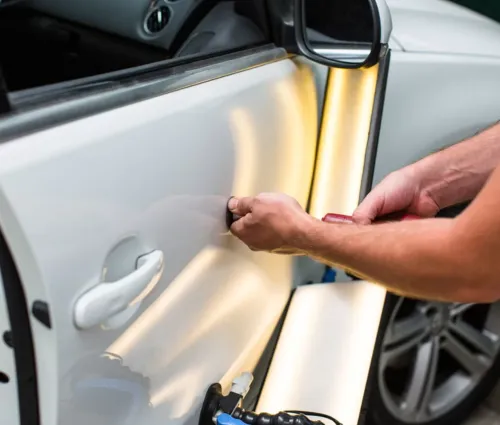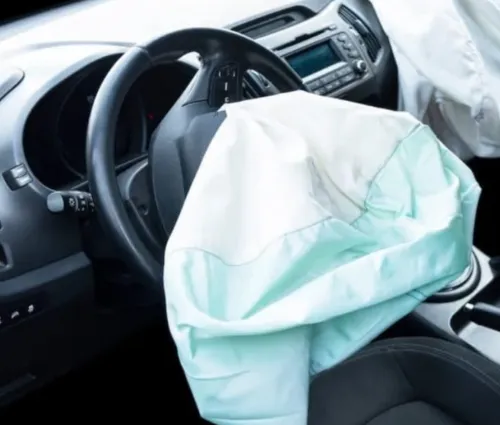Paintless Dent Repair
R&I in Hail Repair: Access Done Right

FSDAVCFEBFEVSDDVFSD

FSDAVCFEBFEVSDDVFSD

FSDAVCFEBFEVSDDVFSD
What Remove & Install Means for PDR

Hail dents commonly appear on broad, flat panels like the hood, roof, and trunk. These dents are usually shallow and uniformly rounded, making them ideal candidates for paintless dent repair (PDR). This technique involves accessing the backside of the panel and gently massaging the metal back to its original shape without disturbing the paint. It’s a precise process that doesn’t involve sanding, fillers, or repainting—so your factory finish remains untouched.
Because the paint isn’t broken, there’s no risk of mismatched colors, clear coat issues, or peeling over time. PDR allows for quick turnaround and is typically more affordable than traditional repairs. It’s also less invasive and environmentally friendly. For hail damage, it’s one of the most reliable and proven repair methods available today—delivering great results without the cost or delay of conventional bodywork.

Components Commonly Removed for Access
Typical R&I for hail repair starts inside the cabin. The headliner is lowered or removed to access roof bracing and outer skin without creasing fabric or bending reinforcements. Overhead consoles, dome lamps, grab handles, and sun visor brackets are cataloged and set aside so push tools and lighting can be positioned accurately above each dent. This preserves original adhesive patterns and labels.
At the rear, tail lamps are removed to reach quarter panels and the hatch. On doors, inner trim panels, vapor barriers, and mirror caps come off to open pathways to the metal. Front ends often need grille inserts or headlamps out for upper fenders. Emblems and moldings are carefully de-badged using non-marring tools.
Every fastener is mapped, and clips are checked for fatigue before reinstallation. This disciplined approach avoids stretching seals, snapping tabs, or scratching painted edges—problems that can occur when access is improvised. Thorough R&I gives Dentex Midwest room to work cleanly, ensuring consistent tool angles, straighter reflections, and a true, factory-quality finish.

Safety Matters: Airbags, Wiring, and Seals
Modern vehicles are packed with sensitive systems. Side-curtain airbags sit behind headliners; connectors, amplifiers, and antennas hide in pillars; wiring looms snake through door shells. Safe R&I means de-energizing where required, unclipping harnesses at designed break points, supporting glass, and protecting painted edges with tape or guards so nothing binds or abrades.
Technicians trained on manufacturer procedures know torque specs, clip orientations, and one-time-use fasteners. They track water barriers and sealants, replace damaged clips, and confirm module wake-up sequences after reassembly. At Dentex Midwest, this discipline keeps airbags ready, electronics stable, and weather-sealing correct—so your PDR results are precise and your warranty coverage remains intact.

Skipping R&I forces tools to work around obstacles. That often means prying against edges, drilling holes, or pushing from awkward angles that telegraph ridges into the paint. Without clean access, tabs get stressed, clips twist, and sealant beads tear—small mistakes that become squeaks, wind noise, or moisture paths months after the hailstorm. Paint edges stay untouched, and factory e-coat remains sealed. Interior fabrics avoid smudges, and headliner scrapes are prevented. No broken clips means tighter fits.
Proper R&I changes all of that. With the headliner down and lamps out, Dentex Midwest technicians can place soft tips and lights exactly where they need them, use longer leverage for smoother pushes, and massage metal in smaller increments. The result is straighter reflections, crisper body lines, and zero evidence of tool marks. Panels reinstall as designed, maintaining panel gaps, water management, and safety. Everything feels OEM-correct after repair.
Why R&I Prevents Hidden Damage
Glue-pulling alone cannot reach every hail dent, especially on double-skinned roofs and braced panels. Where tabs fail to pull cleanly, technicians need backside pushes. R&I provides those pathways without drilling access holes that invite corrosion. By opening trim correctly, we preserve coatings, drainage paths, and sensor placements that keep modern vehicles reliable. It also maintains headliner integrity and prevents imprinting.
Hidden damage during careless access often starts at the micro level. A slipped tool can nick seam sealer; a rushed clip removal can crack a mount ear. Weeks later, rattles begin, or a damp carpet appears after rain. These are preventable outcomes when the plan begins with methodical, documented R&I performed by specialists.
Quality control closes the loop. We test every switch and lamp we disconnect, inspect grommets and vapor barriers, and confirm trim sits flush before final detailing. That diligence pairs with expert PDR to restore straight reflections without overspray, filler, or mismatched color—protecting your vehicle’s value and your confidence after a Missouri hail event.
Time Allowances and Line-Item Costs
R&I takes time because it is precise, not hurried. Estimating platforms include labor allowances for each component—headliner R&I, tail lamp R&I, door trim R&I—reflecting the care required to remove, store, and reinstall correctly.
On your Dentex Midwest estimate, these appear as separate line items. That transparency shows where trained labor is invested and lets insurers approve the right scope. It also protects the finish by avoiding risky shortcuts that might look quicker on paper but cost more when parts crack or paint edges get marred.
Bottom line: R&I is not a fee to pad a bill; it is the craft that enables clean access for dent repair, safer reassembly, and durable results that hold their value.


Because every vehicle is different, R&I time varies with trim level, options, and prior repairs. A panoramic roof, aftermarket sound deadening, or brittle clips on an older model can change the approach. Dentex Midwest evaluates each car in person, photographs attachment points, and outlines the plan so you know exactly what we’ll remove and why. That assessment drives accurate estimating, smoother scheduling, and fewer surprises on delivery—protecting your time, your paint, and your confidence in the repair.
Before and After: With and Without R&I
Scenario A: No R&I. A technician tries to push a roof dent through the headliner, working around a curtain airbag and roof brace. Tool angles are shallow, so pressure spreads and creates slight highs. A clip near the hatch is cracked by accident. The dent mostly improves, but reflections wobble and a rattle develops later. Wind noise grows as the cracked clip loosens, and owners notice later on highways.
Scenario B: Proper R&I. The headliner is lowered, lamps are removed, and brace access is opened. A soft-tip rod reaches the backside directly, and progress is checked with reflection boards and lights. Each push is smaller and better aimed, so the metal relaxes uniformly. Clips are replaced, seals are reset, and everything tightens perfectly. Final inspection confirms electronics function, water paths drain correctly, and trim aligns evenly across panels again.
Results: Scenario B restores crisp lines and undisturbed paint, with zero drill holes, zero pry marks, and a headliner that looks untouched. Scenario A leaves telltales in the finish and weak points in the hardware. That is why Dentex Midwest specifies R&I hail repair up front: better access, safer work, and longer-lasting results. Over time, the properly executed repair resists temperature swings, car washes, and road vibration without returning lows or highs.

Dentex Midwest
Professional Hail Repair & PDR
Stay Up-to-date With Our Content
Subscribe to learn more about our mission!
Stay Up-to-date With Our Content
Subscribe to learn more!
Contact Info
Service Hours
Social Media
Home
Services
Service Areas
Blog
About
Contact
Contact Info
Service Hours
Mon - Fri: 8:00 am – 6:00 pm
Saturday: by Appointment
Sunday: Closed
Social Media

Licensed, bonded, & insured